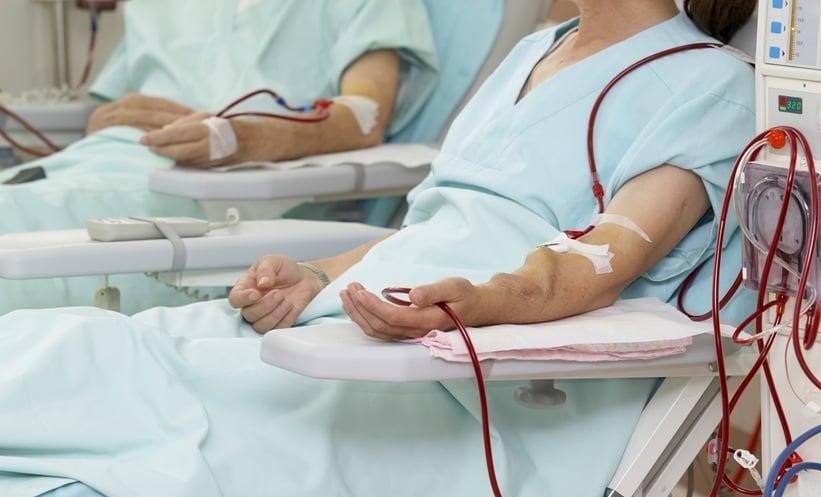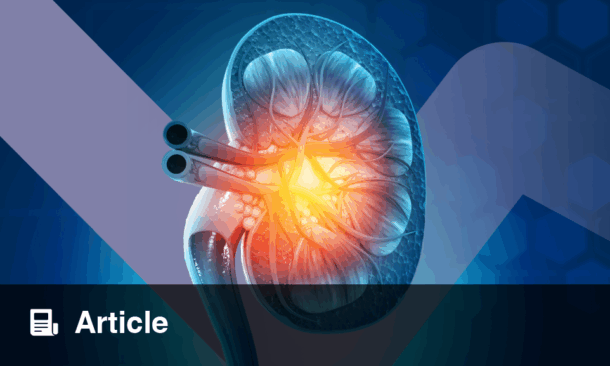Interviewees: Peter Stenvinkel,¹ Alexander R. Rosenkranz²
1. Department of Renal Medicine, Karolinska University Hospital, Karolinska Institutet, Stockholm, Sweden
2. Division of Nephrology, Department of Internal Medicine, Medical University of Graz, Austria
Disclosure: Stenvinkel has been or is on the scientific advisory boards of Reata Pharmaceuticals, FMC, Vifor Pharma, Baxter, and AstraZeneca. Rosenkranz has received consulting fees from Baxter, Vifor Pharma, Boehringer Ingelheim, AstraZeneca, and Astellas Pharma.
Acknowledgements: Medical writing assistance was provided by Juliet George, Chester, UK.
Disclaimer: The opinions expressed in this article belong solely to the two named interviewees.
Support: The publication of this interview feature was supported and reviewed by Baxter.
Citation: EMJ Nephrol. 2022;10[Suppl 1]:2-8.
Summary
Despite recent developments in renal medicine, mortality rates remain high in patients receiving long-term haemodialysis (HD) due to cardiovascular events, infection, and inflammation. Large middle molecules (LMM) are not efficiently removed by standard HD treatment, and evidence suggests that they may have a role in driving cardiovascular damage and inflammatory processes. During interviews conducted by the EMJ in December 2021, two leading specialists in renal medicine and dialysis, Peter Stenvinkel and Alexander R. Rosenkranz, discussed how outcomes may be improved for patients receiving HD. They outlined the mortality risks associated with HD and explored the link between LMM accumulation and cardiovascular and inflammatory effects. Following this, the concept of medium cut-off (MCO) membranes to facilitate the removal of LMMs and so influence HD outcomes was introduced. The impact of the MCO innovation on cardiac and vascular function, the practicalities of HD delivery, and patient quality of life were explored. Taking all of these aspects into account, the experts concluded by considering the future implications of MCO membrane use for patients and families living alongside long-term HD.
INTRODUCTION: MORTALITY RISKS IN HAEMODIALYSIS
The raised risk of cardiovascular damage, infection, and inflammation associated with long-term HD has a marked impact on patient mortality rates. Clinical experts Stenvinkel and Rosenkranz explained that not only is this a challenging situation, but it is one that has seen little advancement over recent decades. According to Stenvinkel: “The mortality rate in this patient group [with long-term HD] is still very high, and in most countries is around 20% per year. Indeed, the mortality rate is as high as for metastatic cancer, such as colon cancer.”
Rosenkranz reinforced this point: “Mortality is still high. I started my training in 1993, and nothing has changed. A paper from 2015 based on the Austrian Dialysis and Transplant Registry (OEDTR), which includes more than 30,000 patients and has existed for over 50 years, compared the mortality risk for patients who started dialysis in 1997–8 with those who started in 2007–8.1 While a reduction in mortality risk was seen for patients with diabetic kidney disease, there was no reduction in mortality for patients with non-diabetic kidney disease receiving dialysis.”1
Concerning this observed lack of improvement in mortality rates, Stenvinkel noted: “Of course, there is a selection [bias] here, because patients who do not receive a transplant, usually the older and sicker patients, remain on dialysis.”
Rosenkranz agreed: “The mean age of patients going into dialysis has increased,1 so it’s likely the morbidity of these patients is higher than 20 or 30 years ago.” He also quoted a publication by Sarnak et al.2 from 2003, which found that the difference in cardiovascular mortality rate between the general population and those with kidney disease receiving dialysis or transplant narrows with increasing age. The experts explained that cardiovascular damage is amongst the greatest risk factors for mortality in patients receiving dialysis.
“The high mortality rates in patients on dialysis are due to cardiovascular disease and infectious complications, and we know that persistent inflammation is a major risk factor that predicts poor outcome in these patients,” said Stenvinkel.
Rosenkranz clarified that current HD therapies are not able to reduce cardiovascular risk and mortality rates more effectively, as they cannot mimic the 24-hour toxin removal of the kidneys. Stenvinkel elaborated on this point, stating that conventional HD is really poor at clearing middle molecules; the uremic toxins with a molecular weight of ≥0.5 kDa, according to categories established by the European Uremic Toxin (EUTox) Work Group in 2003.3-5 He continued: “These are the molecules that may have an impact on morbidity, mortality, and, not least, quality of life. We know that there is an accumulation of uremic toxins in the uremic milieu [the collection of metabolic abnormalities in chronic kidney disease], and we know that these uremic toxins will affect virtually all organs in the body: the cardiovascular system, the endocrine system, the immune system.
This has haematologic, gastrointestinal, nephrologic, and other impacts, and to reduce mortality, you need to get rid of these uremic toxins. That is not currently possible with conventional dialysis therapies.”
LARGE MIDDLE MOLECULES AND CARDIOVASCULAR RISK
As noted above, although standard HD treatment removes smaller solutes effectively, it is much less efficient at removing larger solutes, in particular LMMs (>25–58 kDa),3 and evidence is growing for the role of LMMs in driving the cardiovascular damage and inflammatory processes associated with long-term dialysis.
As background to this concept, Rosenkranz outlined the historical development of HD membranes leading to the current situation and proposals to better target LMMs. “First of all, it was thought you had to remove the small molecules and that would be enough, as it was the first time the patient was seen to survive,” he said. “The next step was to go into more detail and look for markers like β-2 microglobulin (β2M), which was shown to be elevated in the dialysis population. The low-flux membranes couldn’t remove β2M, and it was thought that if β2M was removed then patients would be better off. So, they used a high-flux membrane and haemodiafiltration (HDF); but, of the three large clinical trials (the Dutch CONTRAST study,6 the Turkish OL-HDF study,7 and the Spanish ESHOL study8), only the Spanish study showed a difference in outcome between online-HDF and HD (>90% patients receiving HD treated with high-flux dialysers). In the CONTRAST and OL-HDF studies, a survival benefit was only seen if there was a high ultrafiltration rate and high convection volume in these patients.6,7 So the [nephrology] community was not convinced by high-flux membranes with HDF, which removed middle molecules up to β2M (11.8 kDa),3 but not the larger middle molecules up to average of 35 kDa or 45 kDa like the λ-free light chain,” he concluded.
Given the lack of convincing benefit for the removal of only medium-to-large molecules, the link between LMMs and cardiovascular risk was said to be key to future developments. Stenvinkel summarised this situation: “We know that many of these LMMs have a role in atherosclerotic processes, for example, the pro-inflammatory cytokines. And on top of this, they may have a role in structural cardiac disease and immunodeficiency, which is another problem in this patient group: they are prone to infectious complications.”
While the risks are clearly high, Rosenkranz added that it was important to know that not all patients receiving dialysis experience the same cardiovascular risks. “You have to distinguish between a person who is on dialysis because of diabetes and hypertension (20–30 years of disease with vascular damage which leads to end-stage renal disease), and a person with autoimmune or genetic disease, who loses kidney function in a short period of time and doesn’t have so many cardiovascular complications,” he said.
Malnutrition, Inflammation, and Atherosclerosis
Considering those patients who are at the highest risk of mortality, Stenvinkel described a wasting syndrome that is closely related both to inflammation and atherosclerotic cardiovascular disease, and that is seen in some patients receiving dialysis. He continued to describe the connection between LMMs and the particularly high mortality risk seen in these patients. “There is a strong association between malnutrition, inflammation, and atherosclerosis in patients receiving dialysis.9 LMMs also have a role in protein energy wasting (PEW), and this may be a syndrome reflecting accumulation of LMMs that are not cleared sufficiently by conventional HD. I would think this is why there is greater risk of mortality in these patients,” said Stenvinkel.
However, Rosenkranz shared a different opinion concerning this proposed clinical phenotype. “I am unhappy about linking atherosclerosis and inflammation in a dialysis population, because this link has been mostly shown in patients with normal kidney function and in experimental models where you don’t have the uremic milieu. The cardiovascular death of a patient in the dialysis population is completely different from the cardiovascular death of a patient with normal renal function. They are not dying because of myocardial infarction, they’re dying because of sudden cardiac death,10,11 which is probably something to do with the small vessels, or even electrolyte disturbances. So, the pathophysiology is probably different. I think that inflammation is playing a role, and when there is chronic inflammation, such as during chronic viral infection, there is loss of weight, etc., but it’s very hard to follow that in a uremic milieu,” he commented.
THE ROLE OF MEDIUM CUT-OFF MEMBRANES
In response to greater knowledge of LMM accumulation and the link with mortality risks, a new class of HD membranes known as MCO membranes has been developed. The pore size of MCOs is designed to remove LMMs effectively, and evidence is building for their benefits in reducing cardiac risk, as well as improving patient-reported outcomes. Stenvinkel explained further: “MCOs have been termed under the expanded HD concept: renal replacement therapy that expands blood purification to larger uremic toxins that are not effectively removed by current dialysis therapies (low-flux especially, but also high-flux).
This is enabled by an innovative artificial kidney membrane (MCO), with increased permeability and selectivity. This results in enhanced internal filtration, but without the need for replacement fluids as required by HDF.”
Alongside the enhanced filtration, avoidance of the complication of fluid replacement was described as a clear advantage of the MCO membranes.
Despite these obvious benefits, the experts agreed that gaining evidence from large-scale clinical studies to support the value of MCO membranes is challenging. “There is an association between the level of free light chains and mortality in the chronic kidney disease and dialysis population. So, we could say that if we remove the free light chains, that’s likely to be good,” said Rosenkranz. However, he cautioned that nephrologists have argued in this way in other areas of nephrology for many years, but such outcomes have never been demonstrated in large-scale experimental settings. For example, it was noted that the LMM fibroblast growth factor 23 (FGF23) is connected to hypertrophy and cardiac structure, and that 24 weeks of dialysis with an MCO membrane produced a sustained reduction in FGF23 in an exploratory analysis of the REMOVAL-HD study.12 However, the long-term outcomes of the removal of FGF23 have not yet been proven in a randomised controlled trial. Rosenkranz continued to give other examples: “A membrane permeability outcome study, which compared the high-flux membrane with the low-flux membrane,13 didn’t find the much better outcome with a high-flux membrane that everyone was expecting with the removal of β2M. There are reports of small numbers of patients showing better outcomes related to the removal of complement D or λ-free light chains, even better than with HDF,14 but there is no real clinical endpoint, only the experience of less pruritis or restless legs syndrome, etc. There are no data showing improvement in cardiovascular outcome with MCO membranes because it is very hard to perform this type of study in different dialysis units, as well as regions, as every patient is different (the elderly are very sick before they start dialysis, and there are also incident patients), so you would need 8,000 or 10,000 patients on dialysis in order to enrol 4,000 patients on dialysis who would be appropriate to study. If you only believe in randomised controlled trials, then you would say, ‘Why should I use this MCO membrane?’ However, there is no trial out there showing convincingly that a low-flux membrane performs better than a high-flux membrane in terms of outcome, and that’s the same for a high-flux membrane compared to an MCO membrane from my point of view. There’s no evidence that you are worse off with an MCO membrane, and at least you take out something that you can’t remove with the other methods,” concluded Rosenkranz.
Stenvinkel discussed the matter of study evidence further: “If you have a therapy that reduces circulating levels of LMMs, it should be decreasing the inflammatory component that drives immunodeficiency, atherosclerosis, and PEW. At the moment, we have observational study evidence that MCO membranes clear the LMMs that cause inflammation and PEW,15 which shows a relationship with a decrease in inflammatory markers. We don’t have any hard outcomes yet, and it would be extremely hard to conduct a study looking at mortality rates. However, maybe even more important than hard outcome studies would be to perform studies to show an impact on quality of life, which is usually poor in patients on HD. It’s here the data suggest that MCO membranes may have real potential. What is most impressive from my view are recent data presented showing how MCO membranes could deal with very severe pruritus.16 I think there will be much more hard evidence to come, but data so far indicate that it will be possible for MCO membranes to make quality of life much better in this population.”
Albumin Loss
While MCO membranes remove the LMMs linked to raised mortality risks in HD, naturally the dialysis process also leads to a small loss of other unrelated LMMs, such as albumin. However, the experts did not believe this loss was of clinical significance. “There is a small albumin loss in the range of 2–4 g per session, and it’s the same magnitude as you will find in urine in patients with macroalbuminuric Type 1 diabetes. So, it is a minor loss that I believe is of very little clinical relevance,” stated Stenvinkel. “As nephrologists, we are used to dealing with patients on peritoneal dialysis who have quite considerable losses of albumin in peritoneal fluid, losses of greater magnitude than you will observe with MCO membranes. For me, these minor losses [with MCO membranes] are not an immediate concern,” he concluded.
Rosenkranz shared this view:
“The albumin loss is less than in patients on empirical peritoneal dialysis, and I think that’s probably the most important argument for an MCO membrane: that the outcome of the albumin loss is not an issue, because in empirical peritoneal dialysis, it is not an issue.”
It was also explained that any discussion around albumin loss needs to be balanced by understanding of the complexity of albumin metabolism in patients receiving HD, and the many influencing factors. This is something that Stenvinkel has studied in detail in relation to patients receiving peritoneal dialysis and haemodialysis. “In our hands, there is no doubt that persistent inflammation is the major cause of hypoalbuminaemia. We also have loss of albumin in the urine in patients receiving HD who have residual renal function, and other factors, such as gender, may have an impact. Generally, it has been stated that albumin is a marker of nutritional status but, in our studies, we find that albumin is a very poor marker for nutritional status. It’s merely an inflammatory marker,” he said.
LOOKING TO THE FUTURE
The experts were optimistic over the improvements that could be offered by MCO membranes in the future and described those patients they felt would benefit most. Rosenkranz remarked: “Over the past year, small things have improved and the MCO membrane is one of the next steps. It’s the best membrane we have at the moment because of the uniform pore size in a range where you’re not losing too much albumin. It’s the best balance. It’s more expensive, but you’re going to reach your goal in a better way.”
Adding his view, Stenvinkel said: “The patients I would treat with MCO membranes in the first instance are those who have persistent inflammation and may be at risk of, or even have, the malnutrition, inflammation, and atherosclerosis syndrome. But, of course, this is something that will be established over time during dialysis, so, in order to prevent the occurrence of the syndrome, maybe MCO membranes should be employed more widely.”
Rosenkranz suggested that MCO membranes could be useful to treat patients instead of HDF, and returned to quote the findings of the Spanish ESHOL study, in which a reduction in all-cause mortality with HDF was seen with high convection volumes.8 He noted that a high convection volume can be difficult to achieve in clinical practice, and this is where MCO membranes may also play a role, for example, in patients who are unable to reach a high convection volume due to use of a central venous catheter (CVC), and thus experience reduced efficacy with HDF. In particular, he felt that MCO membranes would display a great advantage where there is a blood flow rate <300 mL/min, as a blood flow rate of >300 mL/min is often not reached by a CVC. MCO membrane dialysis was also said to offer improvements over HDF in terms of practicalities, by simplifying therapy and saving resources. Rosenkranz explained: “We all need ‘green’ [ecologically sound] dialysers so that you are not wasting resources, and this includes water; you use much less water than with HDF, for example. So, this form of dialysis with MCO membranes is greener than other forms of dialysis. It looks like a very safe way to remove LMMs without any additional machinery or any resources. Also, from a nurse’s point of view, it is easier to do regular dialysis than HDF.”
Stenvinkel agreed: “HDF is a more complicated therapy because of the large volumes that need to be replaced, and here MCO membranes represent a major advantage.”
Adding to these notable clinical gains, Stenvinkel re-emphasised that MCO membranes are likely to produce a marked impact on patients’ daily lives. “I think the most important potential benefit of MCO membranes may be the quality-of-life issues, because this is what concerns patients most,” he said. “Patients are concerned with restless legs, nausea, cramps, fatigue, sexual dysfunction, pruritus, and prolonged recovery time after dialysis sessions, all of which have a major impact on not only themselves, but the whole family.” Stenvinkel was also keen to highlight the potential effects of MCO membranes on vascular function in patients receiving dialysis. “There is a lot of scientific evidence showing that vascular function is a major problem in the dialysis patient population and we have an opportunity to lower this risk with MCO membranes. I see great possibility for MCOs to improve vascular function in response to dialysis, and I think this will be an area of interest for further research,” he concluded.
SUMMARY
Across the discussion, Stenvinkel and Rosenkranz highlighted the high rates of mortality experienced by patients receiving long-term HD, and the long-awaited need for change. The advent of a novel approach in the form of the MCO membrane was viewed as a welcome development to enable the removal of LMMs associated with cardiovascular and inflammatory effects. The MCO membrane is seen as providing a clear advantage over conventional membranes, bringing immediate benefits to patients at the greatest risk of mortality. In addition, it was proposed that dialysis with MCOs is likely to be a safer, more effective, and simpler option for some patient groups currently receiving high-flux HDF (such as those with CVCs), or for those who are not suitable for HDF. While the experts acknowledged that large-scale study evidence in the HD field is scarce, they believed MCO membranes to be a marked advancement, which would impact on mortality rates and notably improve everyday life for those living with long-term HD therapy.
Biographies
Peter Stenvinkel
Karolinska Institutet, Stockholm, Sweden
Peter Stenvinkel serves as a full Professor and Senior Lecturer at the Department of Renal Medicine, Karolinska University Hospital, Karolinska Institutet, Stockholm, Sweden. He has published over 600 original publications and reviews, and more than 30 book chapters on various aspects of inflammation, wasting, and metabolism in patients with chronic kidney disease. His Hirsch index is 90 according to PubMed and 117 according to Google Scholar. He has given more than 400 invited lectures at various international meetings and congresses in about 30 different countries.
Alexander R. Rosenkranz
Medical University of Graz, Austria
Alexander R. Rosenkranz is Professor of Nephrology, Head of the Clinical Division of Nephrology, and Head of the Department of Internal Medicine at the Medical University of Graz, Austria. From 2001 to 2011, he headed the Laboratory of Experimental Nephrology and published in the field of experimental acute kidney injury and glomerulonephritis. Lately, he has been involved in the research of vascular calcification and diabetes. He is reviewer for several journals in the field of nephrology. In addition, he is the current President of the Austrian Society of Transplantation and the Austrian Society of Internal Medicine, and a Council member of the European Renal Association (ERA).







